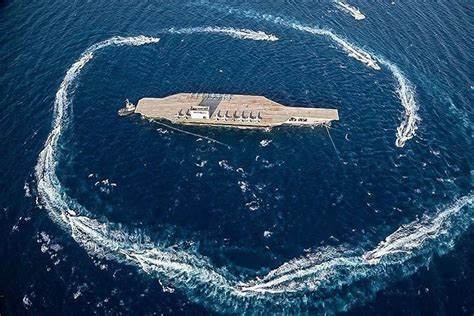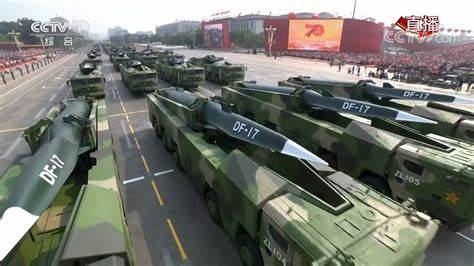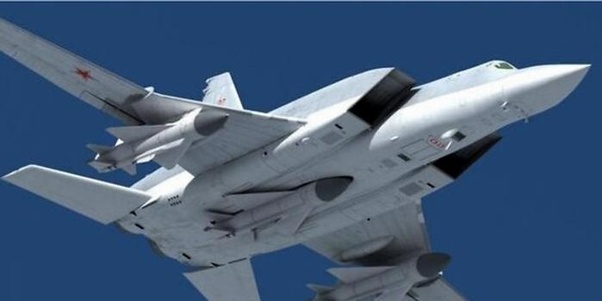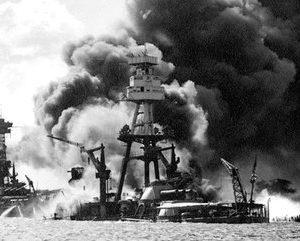Must it be destroyed by a missile? Theoretically, not even one missile is needed!
In 2020, Iran conducted a military exercise called “Great Prophet 14,” where they used small boats to surround and then destroy a simulated US aircraft carrier. This demonstrated their theoretical capability to destroy a carrier when it is close to their coast…

But wait, why would an aircraft carrier be close to the coast of a hostile nation?
Let’s take a standard Nimitz carrier strike group as an example.
A more realistic scenario for a medium-sized country is that, before you even see a US carrier, your command and air defense systems are bombed into rubble by a dozen stealthy F-35C fighter jets.
Then, 30 FA-18E/Fs control the skies of a leaderless nation, while EA-18Gs ensure you hear nothing but noise on all your military and civilian channels. E-2Cs monitor the movements of every flying object larger than a bird in the area, and the aircraft carrier is 1000 kilometers away.
In actual combat, aircraft carriers will not approach the coast of any hostile nation. Instead, an aircraft carrier can neutralize a hostile nation from a thousand kilometers away.
If you want to attack the carrier outside the combat radius of its carrier-borne aircraft, the only effective measure is this:
You would need a massive reconnaissance satellite network, sweeping every corner of the ocean at intervals of mere minutes. After detecting the carrier’s movements, you would need medium-range ballistic missiles specifically designed for anti-ship purposes. These would arrive half an hour later, 2000 kilometers away, over the sea where the carrier was last seen.
After acquiring the target, it would penetrate the atmosphere at hypersonic speeds, performing continuous maneuvers at dozens of Gs of overload to evade interception. Although the Aegis system on Arleigh Burke destroyers is not designed for wildly maneuvering hypersonic targets, it’s still difficult to guarantee a single warhead’s successful penetration against a barrage of interceptors.
Therefore, you would need to launch multiple hypersonic missiles simultaneously to ensure at least one ultimately smashes through the carrier’s flight deck and ignites a massive fire in the hangar.
If there are effective anti-sinking designs and damage-control measures, the large size of an aircraft carrier makes it extremely difficult to sink. The objective of this is not even close to sink it, but to create a large hole in the center of its flight deck, to cause as many explosions and as much chaos as possible, forcing the carrier to withdraw from combat for several months.

Of all the most sci-fi and insane missile systems envisioned by the Soviets, only China currently has such a system in actual deployment.
Furthermore, when you deploy a hypersonic ballistic missile system to intercept a carrier, it is extremely expensive to build—even more so than constructing another aircraft carrier to counter the threat—and it offers fewer capabilities. Ballistic missiles, however, are a niche weapon.
They cannot patrol and reconnoiter in areas far from your homeland, escort civilian vessels, peacefully exert political pressure on other countries, or destroy the air force of a small or medium-sized country in combat! This is why China is still insisting on developing its own aircraft carriers.
Let’s bring the carrier even closer to the coastline. This will expose the important bases within your territory to direct attacks from aircraft carrier strike groups.
Only China and Russia theoretically possess the capability to search for and intercept a squadron of stealth aircraft. While J-20s or Su-57s are fiercely engaging intruders, you would need several squadrons of bombers or several nuclear submarines, carrying heavy supersonic cruise missiles, to break through the interception of carrier-borne aircraft or anti-submarine aircraft, reach the outer layer of the formation, and then launch an even larger number of missiles, hoping some of them reach the carrier. Only China and Russia possess this capability.

The above is the complete list of countries that can actually intercept a Nimitz carrier strike group: Russia, China, and the United States itself. And this is just for one strike group! Effective countermeasures against aircraft carriers are only possessed by superpowers. This means that if aircraft carriers are equipped with carrier-based fifth-generation fighters, they can operate unimpeded in the rest of the world.
This is the difference between theory and reality. Theoretically, an aircraft carrier could be destroyed using extremely simple weapons, such as a few small boats or a sigle conventional subsonic anti-ship missile. In practice, however, this is far more difficult.






